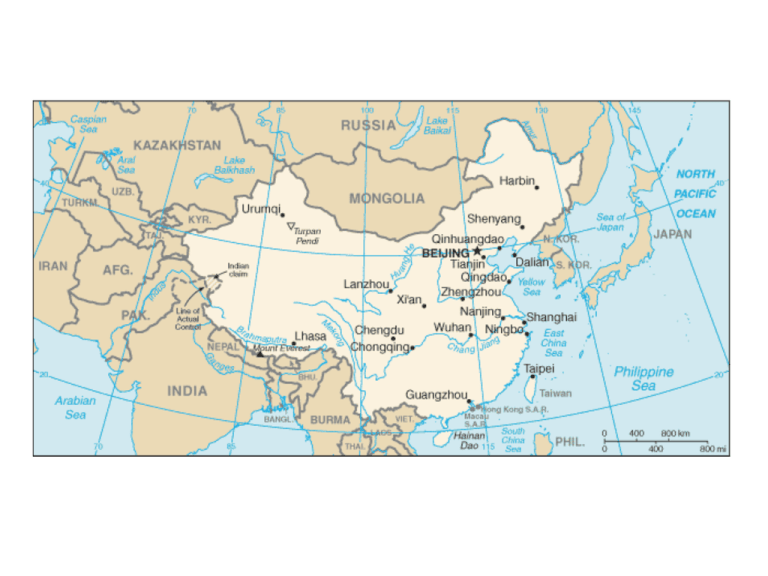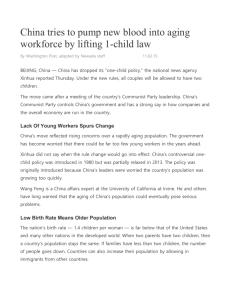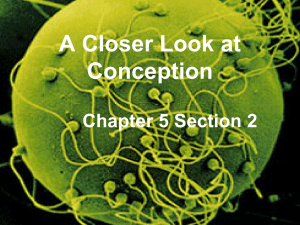Chinese Population Policy
advertisement

DEMOGRAPHIC DATA 2006 Population: 1,313,973,713 Age structure: 0-14: 21% 15-64: 71% 65+: 8% Population growth rate: 0.6% Birth rate: 13‰ Death rate: 7‰ Sex ratio: under 15 years: 118 male/100 female Infant mortality rate: total: 23/1000 male: 21/1000 female: 26/1000 Life expectancy at birth: total population: 73 years male: 71 years female: 75 years Total fertility rate: 1.6 children born/woman POPULATION DENSITY POPULATION STRUCTURE POPULATION POLICIES During Mao Zedong's rule the population policy of China was “the more people, the stronger we are”, leading to overpopulation and a series of famines. When Deng Xiaoping took power in 1978, his new policies focused on strengthening China's economy, and he saw overpopulation as a block to economic development. During the 1960s the population growth rate averaged 2.4% per year 1970 POPULATION POLICY In the 1970s the Chinese government had issued three policies to reduce the birth rate: 1 Late marriage – men were encouraged to marry no earlier than 28 years old (25 in rural areas) and women no earlier than 25 years old (23 in rural areas). 2 Longer spacing between births – couples were encouraged to allow at least a four-year gap after the first child before having another baby. 3 Fewer children – it was suggested that urban families should be limited to two children, and rural families to three children. 1979 POPULATION POLICY – THE ONE CHILD POLICY In 1979 the authorities tightened their control and limited households to only one child. The goal of this policy was to limit China’s population to 1.2 billion by the year 2000. 2002 POPULATION and FAMILY PLANNING LAW Article 8 The State gives rewards to organizations and individuals that have scored outstanding achievements in the population programme and family planning. Article 18 The State maintains its current policy for reproduction, encouraging late marriage and childbearing and advocating one child per couple. Article 19 Family planning shall be practised chiefly by means of contraception. Article 22 Discrimination against, maltreatment and abandonment of baby girls are prohibited. 2002 POPULATION and FAMILY PLANNING LAW Article 23 The State rewards couples who practise family planning. Article 27 The State shall issue to a couple who volunteer to have only one child in their lifetime a “Certificate of Honour for Single-Child Parents”. Couples who are issued the said certificate shall enjoy rewards. Article 35 Use of ultrasonography or other techniques to identify foetal gender for non-medical purposes is strictly prohibited. Sex-selective pregnancy termination for non-medical purposes is strictly prohibited. Article 41 Citizens who give birth to babies not in compliance with the provisions of Article 18 of this Law shall pay a social maintenance fee prescribed by law. 2002 MARRIAGE LAW Article 6 In order to get married, the man shall not be younger than 22 years old and the woman shall not be younger than 20. Late marriage and late child birth shall be encouraged. Article 16 Both husband and wife shall be under the obligation of following the policy of birth control. The Planned Birth policy of the government of the People's Republic of China is known as the One-child Policy LATER Delayed marriage and delayed child bearing LONGER Longer spacing between births FEWER Fewer children – ideally one child per couple ONE CHILD POLICY - EXCEPTIONS • There are no sanctions for couples that have multiple births (i.e twins). • As a result, some wealthy couples are turning to fertility medicines to have multiple births, due to the lack of penalties against couples who have more than one child in their first birth. • Ethnic minorities are formally excluded from the policy (8% of the pop). • If both parents are only children, they are allowed to have more than one child provided the children are spaced more than 4 years apart. • In most rural areas if the first child is a girl couples are allowed to have another child. • Families who have children with mental or physical disabilities are sometimes allowed to have another child. ONE CHILD POLICY - EXCEPTIONS Children born outside of China Some parents manage to be outside the country or in Hong Kong, Macau, or Taiwan when giving birth to their child. Those children do not count in the one-child policy, even if they are technically a natural born Chinese citizen through parentage. As a result the overall fertility rate is closer to two children per family than to one child per family. This population pyramid presents the female minus the male population by age. In most age groups China has a larger male than female population, particularly in young age groups where the "surplus" in male population is substantial. This well-known phenomenon, called "missing girls“, is due to the strong preference for male births in Chinese and most other Asian societies. In the past few decades the one-child policy has certainly contributed, however there has always been an element of cultural favouritism towards boys. It is believed that only boys can later keep up the family tradition. In rural areas, farmers want to have at least one male child to take over the family farm. SUCCESSES and FAILURES The traditional attitude to girls is best described in the ancient "Book of Songs" (1000-700 B.C.): "When a son is born, Let him sleep on the bed, Clothe him with fine clothes, And give him jade to play... When a daughter is born, Let her sleep on the ground, Wrap her in common wrappings, And give broken tiles to play..." Son preference has a long history in China and is tied to the social and economic roles of males in Chinese families. Family lineage is traced through males, and sons are responsible for caring for their parents in their old age. Marriage practices reflect these traditions. When daughters marry, they leave their birth families to join their husbands’ families. In rural areas, few peasants have retirement pensions, so aging parents depend on their children for support. Because daughters have traditionally married out of the family, a couple with no son may end up without financial and personal support. Thus, regardless of their acceptance of the state’s control of population growth, most Chinese citizens want at least one son. SUCCESSES and FAILURES male births 105 female births 100 World China’s sex ratio at birth of 118 male infants for every 100 female infants is likely to be due to 3 factors; underreporting of female births excessive female infant mortality 118 100 China 136 100 Hainan province and prenatal sex determination and sex-selective abortion Current PRC Policies to Combat Son Preference • Laws giving girls and women equal rights with males. • Propaganda and consciousness-raising slogans about the equal value and contributions of females and males. • Laws outlawing infanticide, prenatal sex identification, and sex-selective abortion. • Policies in most provinces allowing rural couples to have two children, or a second child if the first is a girl. • Some localities have preferential policies for couples with daughters but no son, for example modest social security guarantees for the parents. Other possible initiatives • PRC officials and scholars could intensify consultations and information-sharing with other Asian countries that have strong son preference, then try in China whatever works elsewhere. • Focused research in China on what now motivates couples to dispose of daughters, followed by creative strategies to address those concerns. • Enhance the rights of daughters and the responsibilities of daughters toward their natal families throughout their lives. • Land and inheritance rights for females—how to implement? Other Solutions: • Deal with the ethical dilemma of supporting abortion rights in general while discouraging sexselective abortion. • Publicity, education, and propaganda on the human rights of girls and women. Work to change the culture and attitudes. • Increase legal rights of girls and women and vigorously enforce those rights. • Implement and expand social security systems for old age in rural and urban areas, so parents do not have to depend on sons. China 1982, Sex Ratio Ages 0-14 China 1990, Sex Ratio Ages 0-14 China 1995, Sex Ratio Ages 0-14 China 2000, Sex Ratio Ages 0-14 POPULATION PYRAMID 1950 to 2050 In 1950 the population structure of China was typical of a developing country. POPULATION PYRAMID 2005 While the number of children was increasing rapidly between 1950 and about 1970, it is now declining significantly, due to China's one-child family planning program. POPULATION PYRAMID 2050? In the next few decades, China will experience population ageing as can be seen by the shrinking base of the population pyramid and the increasing numbers of people age 50 and above. SUCCESSES and FAILURES China has an ageing population and will have an increasing dependency ratio in the future. As a result of almost 30 years of the one child policy there is a lower ‘active population’, making it more difficult to support the ‘dependent population’. SUCCESSES and FAILURES As the one-child policy approaches the third generation, one adult child supports two parents and four grandparents. This leaves the oldest and most vulnerable generation with increased dependency on retirement funds, the state, or charity for support. SUCCESSES and FAILURES Official government policy opposes forced abortion or sterilisation, but allegations of coercion continue as local officials strive to meet population targets. The one-child policy is criticized as violating basic human rights and China has been accused of meeting its population requirements through bribery, coercion, forced sterilisation, forced abortion, and infanticide. A report in 2001 showed that a quota of 20,000 forced abortions had been set in the province of Guandong due to the reported disregard of the one-child policy. China's population of 1.3 billion is said to be 300 million smaller than it would likely have been without the enactment of this policy. SUCCESSES and FAILURES The world’s two population billionaires, India and China, have national policies to cut population growth. China’s policy has been strictly enforced nationwide and more effective than India’s in reducing fertility and slowing population growth. SUCCESSES and FAILURES China is expected to be overtaken by India as the world’s most populous country in the next 25 years. 2006 China Population: 1,313,973,713 2006 India Population: 1,111,205,474 2050 1,424,000,000 2050 1,807,000,000 SUCCESSES and FAILURES September 2002 An investigation by The Telegraph has revealed that an estimated 50,000 girls and young women, some as young as eight, have been sold or abducted into human slavery in China. The trade is largely the result of the nation's "one child policy", which has led to a shortage of young women and millions of unmarried men. China’s Population: New Trends and Challenges China experienced dramatic declines in birth and death rates over the past 50 years as the government implemented revolutionary and controversial policies to improve health and slow population growth. With 1.3 billion people, China remains the world’s most populous country, but it has lower fertility than the USA and many European countries. Fewer children, later marriage, and longer life expectancy have affected family structures and created new challenges. The growing proportion of elderly in China is beginning to strain both national and family resources. Lower fertility means that fewer children—and sometimes only one child—will be available to care for elderly family members. Movement toward a market economy and opening to international trade in the 1990s brought enormous economic growth, but also increased income and health inequalities, encouraged mass labour migration, and exacerbated environmental damage. The effects of these dramatic changes on China’s fertility, health, economy, and government in the 20th century will ripple through the society for the foreseeable future, and will be felt around the world. FAMILY PLANNING PROPAGANDA FAMILY PLANNING PROPAGANDA FAMILY PLANNING PROPAGANDA FAMILY PLANNING PROPAGANDA FAMILY PLANNING PROPAGANDA FAMILY PLANNING PROPAGANDA FAMILY PLANNING PROPAGANDA FAMILY PLANNING PROPAGANDA




